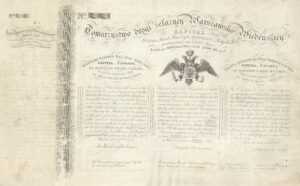| REF. NO. | DENOMINATION | DESCRIPTION | NO.ISSUED | CONDITION | VALUE |
|---|---|---|---|---|---|
| Shares | |||||
 Image courtesy of Boone Shares Image courtesy of Boone Shares |
|||||
| 101 | 1 share, unissued | 1839, vellum | 5000 | VF | €12,870, Boone April 2021 |

Warsaw-Vienna Railway Company (I)
Общество Варшавско-Венской Железной Дороги
Société du Chemin de Fer de Varsovie a Vienne
Warschau-Wiener Eisenbahn-Gesellschaft
Other city spelling: Warszawy
Concession was granted in 1839. Original capital was £500,000 (21,000,000 Polish Florins) in shares of £100 (4,200 Polish Florins). This was the second railway to obtain the Tsar’s approval. It was the first in Europe to have a dividend (4%) with a Government guarantee. Work started in 1839 but ceased in 1842, as the company was unable to raise enough capital. The Imperial Treasury took over the line and it was eventually opened in 1848. See History tab for more detail.
1839
Description
Tsar Nicholas I gave the concession for the railway to its founder, Peter A. Steinkeller, and provided a dividend guarantee to potential shareholders of at least 4%, applicable up to the time when the company came under state control. At that time, an additional premium of 10% of the value of the shares was guaranteed.
The first railway in Russia would normally have been that from St. Petersburg to Moscow but the tsar decided otherwise. In 1835, a 25km test line to the Tsar’s summer residence of Tsarskoye Selo was built; little more than a suburban line. The second line authorized by the Tsar was the Warsaw-Vienna Railway. Steinkeller, with the help of his important sponsor, Count P. Lubenski, had already planned the railway in 1834, but could start construction only after he had received the authorization from the Tsar.
Steinkeller (1799-1854) was a banker and businessman, part of the business elite of Warsaw. He was well qualified: he was from a good background (his father had a trading business in Krakow) and he had important parents-in-law, the Warsaw business and banking family Anthonin, whose banking business he was later to inherit. Also belonging to the Warsaw business elite was Leopold Kronenberg, who came into the company after the death of Steinkeller, and acted as its president for many years. The signature of Leopold Kronenberg is on later shares and bonds of the Warsaw-Vienna Railway.
Of the 5000 founder shares, 1500 were issued to the founders and sponsors in Warsaw and St. Petersburg; 1500 were placed in London and 2000 in Vienna. Three years after the founding of the company (1839), the building of the railway came to a halt through lack of money. The state saw the need to support the railway and in 1843, it became the property of the state. It remained in state ownership until 1857.
After the takeover by the state, work continued. The phases of construction continued outwards along the following sections, which followed one after another: Warsaw-Grodsisk (completed 1845), Warsaw-Skernewitzi-Alexandrow (1845), Rogow-Lowitsch (1845), Rogow-Tschenstochau (1846), Rogow-Sombkowitzi (1847), Sombkowitzi-Sosnowitzi to the frontier station ‘Graniza’, from where there was a junction to Katowice, and another to Vienna (completed 1859). Including these stretches, there were about 300km of line, costing about seven million roubles. The line Warsaw-Kalisch, to the Prussian border, was completed in 1903.
In 1857, the Warsaw-Vienna Railway moved from state ownership to a company founded in that year: the Warsaw-Bromberg (today Bydgoszcz) Railway. The Tsar’s concession was, in that year, extended by a further 75 years. It remained in the ownership of the Warsaw-Bromberg Railway until 1890. From 1890 to 1912 the railway was again an independent, newly-founded, company (founders: Leopold L. Kronenberg, G. Epstein, K. A. Milde, A. Renar, amongst others; president D.P.Palikin). In 1912, the Russian state again took over the Warsaw-Vienna Railway Company.
The Warsaw-Vienna Railway, since it was linked directly to the railway networks of Austria-Hungary and Prussia, used the ‘Western European’ gauge of 1435 mm, while railways built later in the Tsar’s empire used the special ‘Russian’ gauge of 1524 mm. In 1913, the rail network of the Warsaw-Vienna Railway was 749 verst (1,0668 km) long, of which 290 were double-track; it carried 13 million passengers annually and the rolling-stock included 500 steam-locomotives, 15,000 freight wagons and 500 passenger carriages. In that year, the railway employed 19,000 workers and officials.
The initial capital in 1839 was 3 million roubles, but by 1913 had grown to 98.6 million roubles. The profit in 1913 was 17% of the company’s capital. (Source: Erik Meyer, Booneshares)
